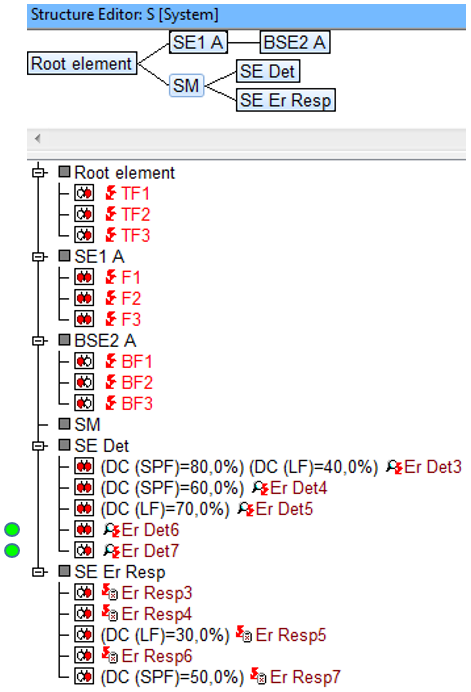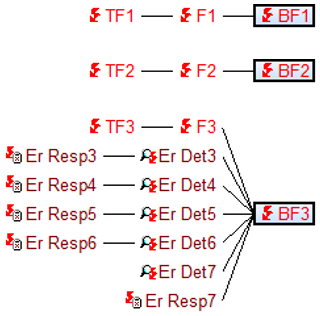Search:
Error detection without DC value
Explanation:
A search will be made for error detections, which have neither a DC-actual value for SPF nor a DC-actual value for LF assigned
Note:
- DC (ISO 26262) = Diagnostic Coverage [%]
- SPF (ISO 26262) = Single Point Fault
- LF (ISO 26262) = Latent Fault
Example:
Abbreviations
- ASIL = Automotive safety integrity level
- BF = Base failure of a base function
- BFn = Base function of a base structure element
- BSE = Base structure element
- Cl Prc = Classification for process characteristic
- Cl Prd = Classification for product characteristic
- Cl Req = Classification for requirement
- CM = Control method
- DA = Detection action
- DC = Diagnostic coverage
- DSCF = Dangerous safety critical failure
- Er Det = Error detection
- Er Resp = Error response
- F = Failure
- FIT = Failure in time
- Fn = Function
- FSM = Functional safety management
- IE = Inspection equipment
- LF = Latent fault
- LFM = Latent fault metric
- OC = Operating condition
- PA = Preventive action
- PE = Process element
- PFH = Probability of failure per Hour
- PMHF = Probabilistic metric for random hardware failures
- PrcC = Process characteristic
- PrdC = Product characteristic
- QM = Quality method
- QR = Quality rule
- Req = Requirement
- RMR = Risk Matrix Ranking
- RP = Reaction plan
- SE = Structure element
- SE ErDet = Structure element for error detections
- SE ErResp = Structure element for error responses
- SFF = Safe failure fraction
- SG = Safety Goal
- SIL = Safety integrity level
- SM = Organisational-SE for “safety mechanisms”
- SPF = Single point fault
- SPFM = Single point fault metric
- TF = Top failure of a top function
- TFn = Top function at root element
- TS = Test sample

- The base failures BF1, BF2 and BF3 are linked to effects F1, F2, and F3 and these in turn are linked to the top failures TF1, TF2, and TF3. Of the three base failures, BF3 is secured several times with safety mechanisms (error detections and error responses). This is shown in detail in the failure net links and/or failure graph links.

- The aim of this Quality Rule is to detect error detections, which have neither DC-actual values for SPF nor DC-actual values for LF. With the Display option “Functional Safety parameters” active, it is possible to see which FSM parameters are assigned to which error detections.
- In this example, there are three error detections and two error responses with such FSM parameters assigned. Note that this Quality Rule only considers the error detections.
Search result: ![]()
Error detections Er Det6 and Er Det7 have neither the DC-actual values for SPF nor LF and therefore are hits in this Quality Rule.